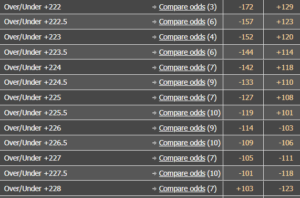What metric should be used to determine who the good sports bettors are? This is one of the most heavily debated topics in the sports gambling world. Touts will commonly post their record and units won as proof that they can indeed predict every game on the board. The true fact of the matter is that beating the closing line is a much better indicator of long term success. An infinitesimally small group of people can win long term over time without beating closing line value. So, what is closing line value (CLV)? How is CLV calculated? What sportsbooks do I use to calculate it? We will cover this all below.
What is Closing Line Value?
Closing line value is the price at which one makes their bet versus the closing line of the bet. As a simple example, let’s say a money line bet is made at the price of +500 and the money line closes at +200. That is awesome closing line value! Regardless of whether the bet wins or losses, if this bet is made at volume over time, then one will end up as a very profitable bettor. The reason for this is that the closing line converted into probabilities is the most accurate prediction of a match up.
What Closing Line Numbers Should I Use?
There are a variety of ways that we can calculate this number. Currently, for our log loss calculations, we use the best line available from the five sportsbooks that are listed on our match up pages.

In this example, the closing lines to use for calculation would be -133 and +125.
In the example above, the values that we would use for calculation would be -133 and +125. While this works, I think that the better values to go off of are the “market-maker” sportbooks. Cris, Bookmaker or Pinnacle are currently the best sportsbooks in this category, and thus, their numbers are the best to use.
Don’t Forget to Remove the Vigorish
Another common mistake in calculating CLV is that people forget to remove the vigorish from their calculation. Let’s say that one is betting basketball money lines and a bet is placed on the Orlando Magic at -110 to beat the New York Knicks. Now, let’s say the line closes at Magic -112 to the Knicks -108. Is that good? Well, not really, because over the long term the vigorish will win out. In this example, if we removed the vig, then the line would be -101/+101 with the Magic as the favorite. -108 is not better than -101, so it should be pretty easy to why vig removal is needed in the calculation.
How Is Closing Line Calculated Without the Vig?
For the money line, it’s actually relatively easy to calculate the line minus the vig. A really easy cheat is to use an online calculator, like the one found here. We will also work through a calculations with another example. Let’s say the Ravens are a -500 money line in a match up against the Bengals who have a money line of +300.

CLV Calculation Example
We first convert the money lines to win probabilities which also allows us to calculate the vigorish (the sportsbooks take if betting dollars are 50/50 on each side). To get the “No Vig Win Probability”, we divide the two converted win probabilities by the totals. We then reverse the math to give us the “Fair Value Odds” which are used to calculate CLV. In this example, if you bet the Ravens at -333 or better, then you have positive expected value (+EV). If you bet the Bengals at +334 or better, then you also have +EV. Both would be considered good bets!
Doesn’t This Get Complicated with Spreads and Over/Unders?

Asian Handicap on an Over/Under
It takes a little bit more research, but in these cases it’s probably best to just hunt down the alternate lines. Meaning, always keep the number bet consistent and just compare the odds. There are a few sites out there where these alternative lines are tracked like OddsPortal. In this instance, one would compare the odds they got versus the no vigorish number at the would be now alternative line.
In Closing…
Focusing on having positive closing line value is the most important thing that a bettor can do. Wins and losses will always be streaky and can be very poor indicators of one’s actual success. Beating the no vig win probability is the metric that will earn you respect from the world’s best sports bettors.